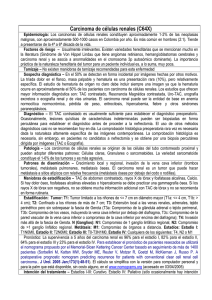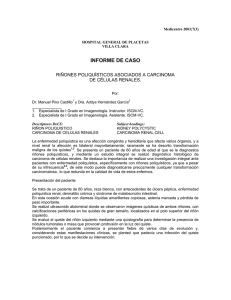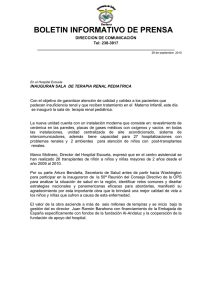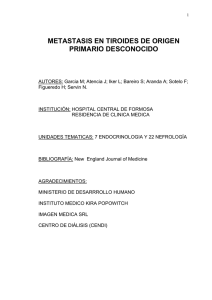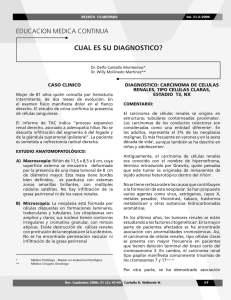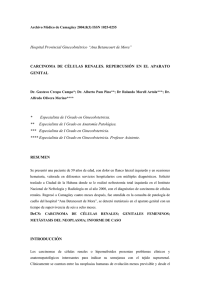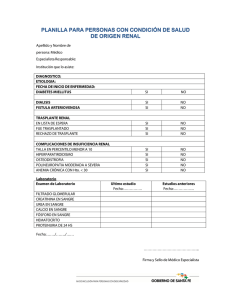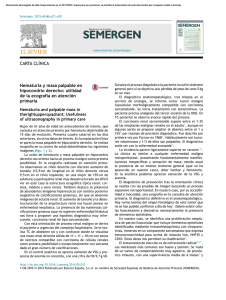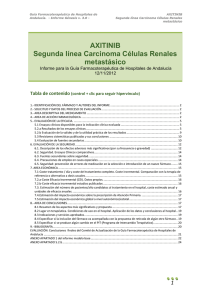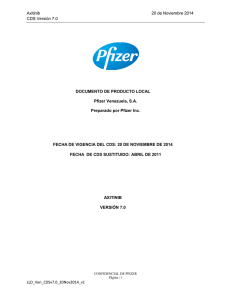pacientes candidatos tercera linea de tratamiento
Anuncio
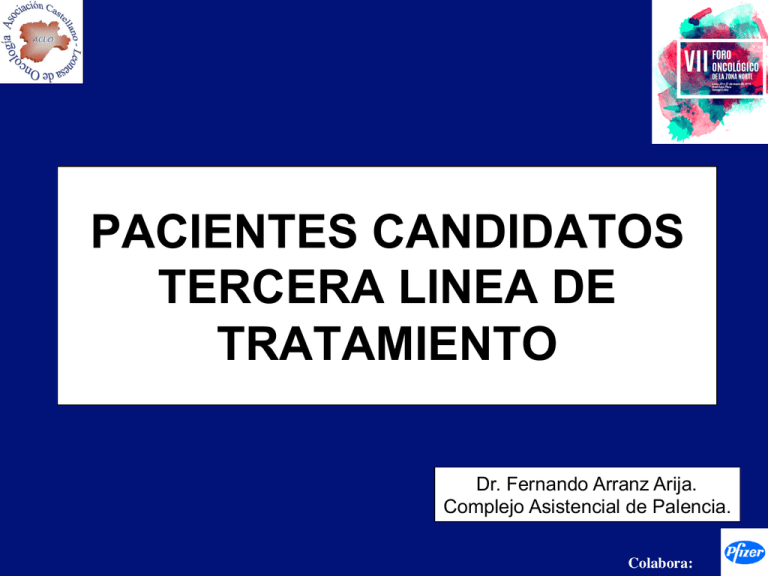
PACIENTES CANDIDATOS TERCERA LINEA DE TRATAMIENTO Dr. Fernando Arranz Arija. Complejo Asistencial de Palencia. Colabora: TREATMENT BEYOND THE SECOND LINE • Patients who have progressed following an initial – molecularly targeted agent and – immunotherapy • may benefit from treatment with an alternative targeted agent. • Patients should be encouraged to participate in formal clinical trials whenever possible. “no se moja” Decisión basada en: • guías-evidencia • eficacia • seguridad • tipo de paciente • familiaridad con el fármaco • agentes disponibles 2ª OPORTUNIDAD Tratamientos disponibles The International Metastatic Renal Cell Carcinoma Database Consortium (IMDC) Recibir 2ª y 3ª línea de tratamiento es factor independiente de mejor SG. • Sólo 1 línea • SG 14,9 m • SLP 6,7 m • Dos líneas • SG 21 m • SLP 3,4 m • Tres o más líneas • SG 39,2 m • SLP 4 m SG se cuenta desde diagnostico SLP desde el inicio de la línea 2015 Genitourinary Cancers Symposium • • • • • • J Clin Oncol 33, 2015 (suppl 7; abstr 430) Everolimus Sorafenib Sunitinib Temsirolimus Pazopanib Axitinib 25% 14% 13% 11% 10% 6%. 47,4 m desde dgno 10,5 m en 4ª línea 3,2 m ¿Tenemos evidencia? ¿para qué fármaco? SORAFENIB • OR:23,5 % • PFS 4 m. • OS 7 m. Dovitinib versus sorafenib for third-line targeted treatment of patients with metastatic renal cell carcinoma: an open-label, randomised phase 3 trial Volume 15, No. 3, p286–296, March 2014 SUNITINIB . PAZOPANIB 82% tratados previamente con TKI en 1ª línea, probablemente Sunitinib • Estudio retrospectivo • 31 pts recibieron pazopanib • 14 en 2ª linea • 17 en 3ª linea • 10 everolimus • 6 Sorafenib • 1 Tensirolimus • Resultados en 3ª : • 6 RP EN 2ª LINEA (19%) • 0% en 3ª linea • 18 SD (58%) • PFS 7,4 m • 11 m en 2ª línea • 3,8 m en 3ª línea • SG no alcanzada AXITINIB he encontrado poco…una publicación de ASCO 2014… Efficacy of axitinib in patients with metastatic renal cell carcinoma previously treated with both VEGFRTKI and mTORI. Journal Of Clinical Oncology, 2014 May 20, Vol.32(15) Suppl S • 12, 9 male and 3 female Japanese patients • Response to axitinib was • PR 2 (17%), • SD 8 (66%), • PD (17%). • The median PFS was 5.2 months. • The median OS was not reached Y de forma indirecta, si SORAFENIB es eficaz y AXITINIB es “superior” en 2ª línea… 2626 Efficacy and safety of axitinib as third line therapy in metastatic renal cell carcinoma (mRCC): Retrospective analysis A. Guida, M. Matias, L. Albiges, L. Derosa, Y. Loriot, C. Massard, K. Fizazi, B. Escudier BEVACIZUMAB +/- INTERFERÓN Activity of Single-Agent Bevacizumab in Patients With Metastatic Renal Cell Carcinoma Previously Treated With Vascular Endothelial Growth Factor Tyrosine Kinase Inhibitors. James D. Turnbull1, Julien Cobert2, Tracy Jaffe3, Michael R. Harrison1, 2, 4, Daniel J. George1, 2, 4, 5, Andrew J. Armstrong1, 2, 4, 5, , Everolimus With or Without Bevacizumab in Treating Patients With Advanced Kidney Cancer That Progressed After First-Line Therapy EVEROLIMUS 2ª vs 3ª 5,4 m. vs 4 m. Eve vs Placebo 4 m. vs 1,8 m. Y apoyado por múltiples estudios retrospectivos … • Albiges L, Bergmann L, Eymard JC , et al. Everolimus for Patients With Metastatic Renal Cell Carcinoma (mRCC) Refractory to Anti‐VEGF Therapy: Preliminary Results of a Pooled Analysis of Noninterventional Studies. Presented at the 2013 Genitourinary Cancers Symposium, Orlando, Florida, February 14—16, 2013. Abstract 392. • Alimohamed N, Lee JL, Srinivas S et al. A Population‐Based Overview of Sequences of Targeted Therapy in Metastatic Renal Cell Carcinoma. Clin Genitourin Cancer. 2014 Aug;12(4):e127-31 • Buchler T, Bortlicek Z, Poprach A, Kubackova K, Kiss I, Zemanova M, Fiala O, Dusek L, Vyzula R, Melichar B; on behalf of the Czech Renal Cancer Cooperative Group. Efficacy of everolimus in second‐ and third‐line therapy for metastatic renal cell carcinoma: A registry‐based analysis. Urol Oncol. 2014 Mar 11. pii: S1078‐1439(13)00509‐7. doi: 10.1016/j.urolonc.2013.12.007. [Epub ahead of print]. • Busch J, Seidel C, Erber B, et al. Retrospective comparison of triple‐sequence therapies in metastatic renal cell carcinoma. Eur Urol. 2013 Jul;64(1):62-70. • Calvani N, Morelli F, Chiuri V, et al. Prolonged exposure to tyrosine kinase inhibitors or early use of everolimus in metastatic renal cell carcinoma: are the two options alike? Med Oncol. 2013;30(2):578. • Harada KH, Miyake HM and Fujisawa MF. Sequential use of mammalian taget of rapamycin inhibitors in patients with metastatic renal cell carcinoma following failure of tyrosin kinase inhibitors. The journal of Urology 2014; 191 4S • Harrison MR, George DJ, Walker MS et al., “Real World” Treatment of Metastatic Renal Cell Carcinoma in a Joint Community‐Academic Cohort: Progression‐Free Survival Over Three Lines of Therapy. Clin Genitourin Cancer. 2013 Dec;11(4):441‐50. • Lacovelli R, Cartenì G, Sternberg CN, et al. Clinical outcomes in patients receiving three lines of targeted therapy for metastatic renal cell carcinoma: Results from a large patient cohort. European Journal of Cancer 2013;49:2134–2142. • Kumano M, Miyake H, Harada K et al. Sequential use of mammalian target of rapamycin inhibitors in patients with metastatic renal cell carcinoma following failure of tyrosine kinase inhibitors. Med Oncol. 2013;30(4):745. • Maj‐Hes A, Medioni J, Scotte F, et al. Rechallenge with mTOR inhibitors in metastatic renal cell carcinoma patients who progressed on previous mTOR inhibitor therapy. Oncology 2013;85:8–13. • Pal S, Malangone E, Bhurke S, et al. Real World Treatment Patterns in Third‐line Patients with Metastatic Renal Cell Carcinoma (mRCC) –The Changing andscape in the United States. Presented at the American Society of Clinical Oncology Genitourinary Cancers Symposium, February 14–16, 2013, Orlando, FL. • Maute L, Grünwald V, Weikert S, Kube U, Gauler T, Kahl C, Burkholder I, Bergmann L. Therapy of mRCC beyond mTORinhibition in clinical practice: results of a retrospective analysis. J Cancer Res Clin Oncol. 2014 Feb 21. [Epub ahead of print] Y también datos para 2ª oportunidad con m-TOR Tensirolimus/Everolimus • 12 pacientes • 3ª o 4ª línea de tratamiento tras • 1 ó 2 anti VEGF • 1 mTOR • Recibieron un 2 y 3 er mTOR • 7 EVE-----TEN • 5 TEN-----EVE • Independiente de la secuencia: • 50 % respondieron a Everolimus • 33 % respondieron a Tensirolimus Sin embargo, everolimus parece haber perdido fuerza últimamente CABOZANTINIB NIVOLUMAB NIVOLUMAB ORIGINAL ARTICLE Nivolumab versus Everolimus in Advanced Renal-Cell Carcinoma Robert J. Motzer, M.D., Bernard Escudier, M.D., David F. McDermott, M.D., Saby George, M.D., Hans J. Hammers, M.D., Ph.D., Sandhya Srinivas, M.D., Scott S. Tykodi, M.D., Ph.D., Jeffrey A. Sosman, M.D., Giuseppe Procopio, M.D., Elizabeth R. Plimack, M.D., Daniel Castellano, M.D., Toni K. Choueiri, M.D., Howard Gurney, M.D., Frede Donskov, M.D., Ph.D., Petri Bono, M.D., Ph.D., John Wagstaff, M.D., Thomas C. Gauler, M.D., Takeshi Ueda, M.D., Ph.D., Yoshihiko Tomita, M.D., Fabio A. Schutz, M.D., Christian Kollmannsberger, M.D., James Larkin, M.D., Ph.D., Alain Ravaud, M.D., Ph.D., Jason S. Simon, Ph.D., Li-An Xu, Ph.D., Ian M. Waxman, M.D., and Padmanee Sharma, M.D., Ph.D. for the CheckMate 025 Investigators N Engl J Med 2015; 373:1803-1813November 5, 2015DOI: 10.1056/NEJMoa1510665 56 pts Quimioterapia Wien Klin Wochenschr. 2005 Jan;117(1-2):63-5. Major response and clinical benefit following third-line treatment for Bellini duct carcinoma. (CDDP-GEM tras IL/IF y Talidomida) Fakhrai N1, Haitel A, Balassy C, Zielinski CC, Schmidinger M. Tratamiento soporte/paliativo Clinical Trial Participants With Metastatic Renal Cell Carcinoma Differ From Patients Treated in Real-World Practice JOP Nov 1, 2015:491-497; published online onSeptember 1, 2015, ESTUDIO RETROSPECTIVO DE UN CENTRO CON GRAN VOLUMEN “24 pts” Conclusiones • Los agentes anti-diana han mejorado el pronóstico del CR de forma muy importante, sin embargo, la aparición de resistencias es la norma • En caso de resistencia se puede tratar por una vía alternativa, aunque • Se acumulan los datos que apoyan el re-tratamiento posterior de la misma vía inicial, sobre todo si: • RO a tratamiento previo • Largo periodo de SLP en tratamientos con TKI • RO 17 %, SD 50% • En pacientes respondedores, respuestas prolongadas de 9 m • Esperamos con interés los resultados de ensayos aleatorizados y de tratamientos inmunomoduladores. Molecular Subtypes of Clear Cell Renal Cell Carcinoma Are Associated with Sunitinib Response in the Metastatic Setting 1. Benoit Beuselinck1,2,3,5, Sylvie Job6, Etienne Becht2,3,4, Alexandra Karadimou1,2,3, Virginie Verkarre2,7, Nicolas Giraldo2,4 Nathalie Rioux-Leclercq8, Vincent Molinié9, Mathilde Sibony2,10, Reza Elaidi5, Corinne Teghom5, Jean-Jacques Patard11,Arnaud Méjean2,5, Wolf Herman Fridman2,3,4, Jessica Zucman-Rossi1,2,3,5,* • 4 TIPOS MOLECULARES DISTINTOS, CON DISTINTO MICROAMBIENTE, y CON DISTINTA RESPUESTA A INMUNOTERAPIA Y A SUNITINIB
